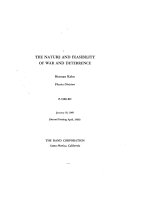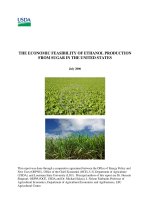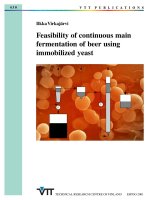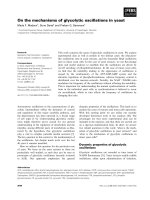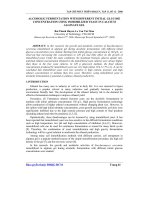FEASIBILITY OF CONTIMUOUS MAIN FERMENTATION OF BEER USING IMMOBILIZED YEAST pot
Bạn đang xem bản rút gọn của tài liệu. Xem và tải ngay bản đầy đủ của tài liệu tại đây (812.7 KB, 92 trang )
430
V T T
P U B L I C A T I O N S
Ilkka Virkajärvi
Feasibility of continuous main
fermentation of beer using
immobilized yeast
P
P
TECHNICAL RESEARCH CENTRE OF FINLAND
ESPOO 2001
VTT PUBLICATIONS 430
Feasibility of continuous main
fermentation of beer using
immobilized yeast
Ilkka Virkajärvi
VTT Biotechnology
Dissertation for the degree of Doctor of Science in Technology to be presented with due permission for
public examination and debate in Auditorium KE 2 at Helsinki University of Technology (Espoo,
Finland) on the 9th of March, 2001, at 12 o'clock noon.
TECHNICAL RESEARCH CENTRE OF FINLAND
ESPOO 2001
ISBN 951–38–5840–5 (soft back ed.)
ISSN 1235–0621 (soft back ed.)
ISBN 951–38–5841–3 (URL: />ISSN 1455–0849 (URL: />Copyright © Valtion teknillinen tutkimuskeskus (VTT) 2001
JULKAISIJA – UTGIVARE – PUBLISHER
Valtion teknillinen tutkimuskeskus (VTT), Vuorimiehentie 5, PL 2000, 02044 VTT
puh. vaihde (09) 4561, faksi (09) 456 4374
Statens tekniska forskningscentral (VTT), Bergsmansvägen 5, PB 2000, 02044 VTT
tel. växel (09) 4561, fax (09) 456 4374
Technical Research Centre of Finland (VTT), Vuorimiehentie 5, P.O.Box 2000, FIN–02044 VTT, Finland
phone internat. + 358 9 4561, fax + 358 9 456 4374
VTT Biotekniikka, Prosessitekniikka, Tietotie 2, PL 1500, 02044 VTT
puh. vaihde (09) 4561, faksi (09) 455 2103
VTT Bioteknik, Processteknik, Datavägen 2, PB 1500, 02044 VTT
tel. växel (09) 4561, fax (09) 455 2103
VTT Biotechnology, Process Technology, Tietotie 2, P.O.Box 1500, FIN–02044 VTT, Finland
phone internat. + 358 9 4561, fax + 358 9 455 2103
Cover picture: SEM micrograph by Paula Raivio, VTT Building and Transport
Technical editing Leena Ukskoski
Text preparing Arja Grahn
Otamedia Oy, Espoo 2001
Virkajärvi, Ilkka. Feasibility of continuous main fermentation of beer using immobilized yeast.
Espoo 2001. Technical Research Centre of Finland, VTT Publications 430. 87 p. + app. 50 p.
Keywords
beverages, beer, brewing, primary fermentation, immobilized yeasts, carriers,
stability, flavours, microbes, contamination
Abstract
Fermentation is the most time consuming step in the production of beer and
therefore the effective use of fermentation vessels is a crucial element in
brewing economy. One means of increasing the productivity of a batch process
is to convert it to a continuous one. Experiments in continuous fermentation
emerged during the 1950s and 1960s, but by the end of 1970s most of them had
been closed down. Immobilization technique revitalised continuous fermentation
research in the 1980s and led to industrial applications in the secondary
fermentation and in the production of low-alcohol beers.
This work demonstrated that an immobilized, continuous main fermentation is a
feasible process for production of lager beer. The immobilized main fermentation was stable for more than 14 months both in fermentation efficiency
and in aroma compound formation. The formation of aroma compounds could
be controlled by varying the composition and amount of gas feed into the first
fermentation stage. The division of immobilized main fermentation into an
aerobic and an anaerobic stage appeared to solve problems related to yeast
growth and viability.
The carrier material affected the formation of flavour compounds in small-scale
fermentations. Moreover the effect varied with the yeast strain used. The carrier
affected the economy of immobilized fermentation: the carrier cost could be as
high as one third of the investment. When a cheap carrier is used the investment
cost for a continuous, immobilized process was estimated to be only about 70%
of the investment cost of a batch process.
3
4
Preface
This work was carried out at VTT Biotechnology during the years 1995–2000.
The work formed a part of a wider project of the Finnish malting and brewing
industry aiming at continuous production of beer using immobilized yeast.
Financial support was provided by the Finnish malting and brewing industry and
Tekes, the National Technology Agency, which is gratefully acknowledged.
I am very grateful to Prof. Matti Linko, the former Laboratory Director, for his
encouragement to write papers and this thesis. I also thank the present Research
Director, Prof. Juha Ahvenainen, for providing excellent working facilities and
the possibility to finalise this work. Prof. Katrina Nordström provided many
valuable comments during the writing phase. Prof. Timo Korpela and Doc.
Pekka Reinikainen I thank for the critical reading of the manuscript.
My special thanks go to my co-authors. Jukka Kronlöf, PhD and Esko Pajunen,
MSc provided valuable viewpoints from practical brewing. Nana Lahtinen, MSc
(née Pohjala), Katri Lindborg, MSc and Terhi Vauhkonen, MSc I thank for their
pleasant co-operation, keen attitude and interesting discussions. Erna Storgårds,
PhD I thank for continuously reminding that there exist more microorganisms
than brewer's yeast – even in a brewery. To Silja Home, Dr. Sci. (Tech.) go my
special thanks for her encouragement, continuous pressure to improve my
writing and valuable discussions.
This work would not have been possible without the pleasant and occasionally
humorous environment generated by all my colleagues at VTT Biotechnology,
especially those of the former Brewery group. Hannele Virtanen MSc, Airi
Hyrkäs, Marita Ikonen, Kari Lepistö, Arvi Vilpola and especially Eero Mattila
have all helped throughout the years.
Lastly, I express my warmest thanks to Seija, Jussi and Juuso for letting me pile
papers at home and for understanding my occasional absent-mindedness.
5
List of the original publications
This thesis is based on the following original publications, which are referred to
in the text by their Roman numerals:
I
Virkajärvi, I. and Linko, M. 1999. Immobilization: A revolution in
traditional brewing. Naturwissenschaften, Vol. 86, pp. 112–122.
II
Virkajärvi, I. and Kronlöf, J. 1998. Long-term stability of immobilized
yeast columns in primary fermentation. J. Am. Soc. Brew. Chem., Vol.
56, No. 2, pp. 70–75.
III
Virkajärvi, I., Lindborg, K., Kronlöf, J. and Pajunen, E. 1999. Effects of
aeration on flavour compounds in immobilized primary fermentation.
Monatsschrift für Brauwissenschaft, Vol. 52, No. 1/2, pp. 9–12, 25–28.
IV
Virkajärvi, I. 1999. Profiting from immobilized fermentation. Proc. 5th
Aviemore Conf. Malting, Brewing and Distilling, Aviemore, 25–28 May
1998. London: Institute of Brewing. Pp. 290–293.
V
Virkajärvi, I. and Pohjala, N. 2000. Primary fermentation with immobilized yeast: some effects of carrier materials on the flavour of the
beer. J. Inst. Brew., Vol. 106, No. 5, pp. 311–318.
VI
Virkajärvi, I., Vauhkonen, T. and Storgårds, E. 2000. Control of microbial
contamination in continuous primary fermentation by immobilized yeast.
J. Am. Soc. Brew. Chem. Accepted for publication.
Some additional unpublished data are also presented.
6
Contents
Abstract................................................................................................................. 3
Preface .................................................................................................................. 5
List of the original publications ............................................................................ 6
Abbreviations and terms ....................................................................................... 9
1. Introduction................................................................................................... 11
2. Beer fermentation and the brewing industry................................................. 12
2.1 Beer fermentation ................................................................................ 12
2.2 Beer flavour ......................................................................................... 13
2.3 Brewing industry ................................................................................. 14
2.4 Productivity of beer fermentation........................................................ 16
3. Continuous beer fermentation....................................................................... 18
3.1 Continuous, non-immobilized processes............................................. 18
3.1.1 Early attempts ......................................................................... 19
3.1.2 Large scale attempts................................................................ 20
3.1.3 Reasons for failure of continuous, non-immobilized
fermentations........................................................................... 24
3.2 Continuous, immobilized processes .................................................... 28
3.2.1 The Bio-Brew Bioreactor........................................................ 31
3.2.2 The continuous main fermentation system developed by Baker
and Kirsop ............................................................................... 33
3.2.3 Alginate as carrier for brewing................................................ 34
3.2.4 Use of immobilized yeast in batch fermentation..................... 34
3.2.5 Process development at Kirin Brewery Company Ltd., Japan 35
3.2.6 Process development at Labatt Breweries of Canada ............. 37
3.2.7 Process development at Meura Delta, Belgium ...................... 38
3.2.8 Process development at Sapporo Breweries Ltd., Japan ......... 40
3.2.9 Semi-industrial main fermentation at Hartwall Plc, Finland... 40
3.2.10 Some other relevant experiments in immobilized main
fermentation ............................................................................ 41
3.2.11 Flavour and economy.............................................................. 43
7
4. The aim of this study .................................................................................... 46
5. Materials and methods .................................................................................. 47
5.1 The state of the art in 1998 (I) ............................................................. 47
5.2 Microbial and flavour stability (II) ...................................................... 47
5.3 Control of flavour (III and V).............................................................. 48
5.4 Effects of a contaminating bacterium (VI) .......................................... 48
5.5 Economics (IV) ................................................................................... 49
6. Results .......................................................................................................... 50
6.1 Long term stability (II) ........................................................................ 50
6.1.1 The apparent degree of attenuation ......................................... 50
6.1.2 Asepticity ................................................................................ 51
6.2 Flavour stability (II) ............................................................................ 51
6.3 Control of flavour (III) ........................................................................ 55
6.4 The effects of carrier material on the flavour of beer (V)........................ 57
6.5 Contamination (VI) ............................................................................. 59
6.6 Economics (IV) ................................................................................... 61
7. Discussion..................................................................................................... 64
7.1 Long term stability .............................................................................. 64
7.2 Control of flavour ................................................................................ 65
7.3 The effect of carrier material on flavour ............................................. 66
7.4 Contamination ..................................................................................... 67
7.5 Economics ........................................................................................... 68
7.6 Compendium ....................................................................................... 69
8. Summary and conclusions ............................................................................ 71
References........................................................................................................... 73
Appendices
Publications I–VI
Appendices of this publication are not included in the PDF version.
Please order the printed version to get the complete publication
( />
8
Abbreviations and terms
CSTR
continuously stirred tank reactor
DEAE
diamino diethyl
DMS
dimethyl sulphide
FAN
free amino nitrogen
GDC
granulated diamino diethyl modified cellulose carrier material
(Spezyme® GDC 220)
HFCS
high fructose corn syrup
hl
hectolitre, a usual measure of volume within the brewing industry,
equals 100 litres
PBR
packed bed reactor
VDK
vicinal diketones
°P
degrees of Plato (weight per cent of solids in wort)
Apparent degree of fermentation
100* (original gravity – present gravity)/original gravity %, measures
the extent of fermentation
Attenuation limit
the maximum attainable degree of fermentation, a property of wort
(and of the yeast strain used)
9
Green beer
beer after primary fermentation, which usually has high concentrations
of vicinal diketones, also called young beer
Main fermentation
the first fermentation step in the production of lager beer, also called
primary fermentation; most of the flavour compounds are formed in
main fermentation
Primary fermentation
main fermentation
Secondary fermentation
the second fermentation step in the production of lager beer, also called
lagering and maturation; the main purpose is to remove buttery
off-flavour and its precursors to an acceptable level
Vicinal diketones
diacetyl and 2,3-pentanedione, which are responsible for buttery
off-flavour. This flavour may be essential in some ales, as it is in some
red vines.
10
1. Introduction
Brewing has changed from home brewing into very large-scale manufacturing.
Most beer is brewed by large companies, but on the other hand, the number of
small or very small breweries has increased in recent years. The competitive
factor for these small breweries is not price, but beers that differ from
mainstream beers. In recent years the tendency for globalisation has been
evident, with brewing companies acquiring breweries all over the beer drinking
world. This will make the market very competitive. Beer is a consumer product
for which the image is very important. Another important factor in consumer
products is the price. Only with a very efficient production and distribution chain
can the brewery make this factor work its advantage. However, every step taken
in cost reduction must preserve the flavour of the product.
Christensen (1997) showed that sometimes the market-leading, profitable and
well-managed companies fail to see and react to a change that will eventually
lead to loss of market dominance. Typically this change originally has a lower
performance than existing technologies, but its faster rate of improvement
rapidly changes the situation. Products of new technologies have features that
customers value: cheaper, simpler, smaller and more convenient to use.
Christensen (1997) called this event disruptive technological change. Examples
in his book include companies in hard disk manufacturing, steel making, and
excavator manufacturing, and thus the idea of disruptive technological change
appears to be rather universal and may be extendable to the brewing industry.
Process biotechnology has advanced enormously by science-oriented and
innovative brewmasters. They have published a great number of papers and
patents and established even large-scale continuous fermentation units.
However, by the late 1970s almost all of the continuous fermentation units had
disappeared, leaving a bitter aftertaste of disappointment.
The present study deals with the challenges of continuous processes for brewing.
It attacks the problems encountered in continuous main fermentation of beer and
uses immobilization technology to solve these problems.
11
2. Beer fermentation and the brewing
industry
2.1 Beer fermentation
All beers in the early days of brewing were produced using top fermenting yeast
strains, but today lager beers, which are produced with bottom fermenting yeast
– developed only about 150 years ago – dominate throughout the world. Below
is a very short description of the brewing process for lager beer.
The first step of brewing is mashing in which malt is milled or ground and
mixed with water. The enzymes of malt hydrolyse biopolymers: starch to mono-,
di-, trisacchrides and dextrins, glucans to oligosaccharides, proteins to amino
acids and peptides (Hough et al. 1971). A brewmaster uses a temperature profile
to control the extent of these hydrolyses. Mashing takes about two hours. After
mashing the insoluble fraction of malt, spent grains, is removed in either a lauter
tun or a mash filter. Lautering normally lasts about 3–4 hours, although new
designs of lauter tuns and mash filters have shortened the process to about 2
hours.
The next step is cooking, in which the wort is boiled for 1–2 hours. During the
boiling, hops or hop products are added into the wort. Boiling ensures the
asepticity needed, precipitates protein-polyphenol complexes, solubilises and
isomerises hop components, removes certain off-flavours and brings the wort to
desired gravity (Hough et al. 1971). Enzymes are inactivated during the boiling.
The precipitated material is removed usually by a whirlpool (a wort cyclone),
which again takes about one hour. Then the wort is cooled to fermentation
temperature, aerated and pitched, usually in the transfer line to the fermenter
(Hough et al. 1971). One fermenter may receive one or more batches of wort.
Which of these batches are pitched and aerated are particular practices of a
brewery. This is a description of all malt brewing, but other sources of
fermentable sugars can be used: unmalted barley or cereal starch, which are
added into the mash tun, or sugars and syrups, which are added into the wort
kettle. The addition of hydrolytic enzymes in mashing may become necessary
with the use of unmalted barley or starch.
12
The lager beer fermentation is divided into two phases: the main fermentation
and the secondary fermentation. The main fermentation lasts from 6 to 10 days
and temperatures used are between 7 and 15oC. Temperature profiles may also
be used. During the main fermentation most of the flavour compounds are
formed. At the end of the main fermentation the beer is cooled down to about
4oC and most of the yeast is separated from the beer. The secondary
fermentation can be performed in the same vessel as the main fermentation or
the beer can be transferred into a second vessel. The main objective of the
secondary fermentation is to remove diacetyl, which causes an off-flavour in
lager beer. The secondary fermentation normally lasts between one and two
weeks, but even six-week times have been reported by brewing companies. The
latter time was common before the lagering temperature was increased from 0oC
to 10–15oC (Linko and Enari 1967).
Finally, the beer is stabilised by cooling it down to 0oC or even lower and by
maintaing this temperature for up to 3 days. Different stabilising agents (i.e.,
silica gels, polyvinylpolypyrrolines, tannins) may be used. Yeast and proteinpolyphenol complexes precipitate and these are then filtered off. Carbonating
and packaging ends the production.
2.2 Beer flavour
Beer is a complex aqueous solution containing CO2, ethyl alcohol, several
inorganic salts and about 800 organic compounds (Hardwick 1995a). The
flavour of beer must be preserved despite changes in the process. The flavour of
beer is determined by the raw materials used, by the process and by the yeast.
The compounds produced by yeast during the fermentation exert the greatest
impact on the palate and on smell. Alcohols, esters, organic acids, carbonyl
compounds and sulphur-containing compounds are the most important flavour
compounds formed by yeast.
Ethyl alcohol has the highest concentration of alcohols in beer and it has an
impact on the flavour of beer. Of the higher alcohols 3-methyl butanol (isoamyl
alcohol) and 2-methyl butanol (amyl alcohol) also have an impact on the flavour.
Other higher alcohols affect the flavour of beer through their cumulative effect
as they seldom exist in concentrations exceeding their individual taste thresholds
13
(Meilgaard and Peppard 1986). Alcohols have taste thresholds approximately 10
times higher than esters and approximately 1000 times higher than carbonyl
compounds, so despite their high concentration their impact on flavour is not the
most important.
Esters are important flavour compounds in beer. Ethyl acetate, 3-methyl butyl
acetate (isoamyl acetate), ethyl hexanoate (ethyl caproate), ethyl octanoate (ethyl
caprylate) and 2-phenyl acetate are the major esters found in beer (Dufour and
Malcorps 1994). According to Dufour and Malcorps (1994) 3-methyl butyl
acetate was above its taste threshold in 90% of the European lagers tested,
whereas ethyl acetate exceeded its taste threshold in less than 50% of the beers
tested.
Beer is slightly acidic. Carbonic acid and organic acids are responsible for a
positive taste effect, mild tartness, in beer (Hardwick 1995a). The organic acids
are all essentially by-products excreted by yeast. Acetic, capric, caproic and
caprylic acids are among the most flavour-active acids in beer.
Of the carbonyl compounds, acetaldehyde and diacetyl are the most important.
Acetaldehyde may exceed its taste threshold during the active phase of
fermentation, but normally in the later phase of fermentation it is reduced to
ethanol (Angelino 1991). Diacetyl is the key flavour compound in secondary
fermentation. The buttery off-flavour in beer caused by diacetyl is removed
during the secondary fermentation.
Sulphur-containing compounds come mainly from malt, but hops may also have
sulphur residues (Hardwick 1995a). The yeast-derived sulphur-containing
compounds include hydrogen sulphide and sulphur dioxide. Normally these are
removed from the beer during the fermentation, but in some cases this may not
occur (poor yeast condition or slow fermentation) and off-flavour of rotten egg
or burnt match may be detected (Angelino 1991).
2.3 Brewing industry
In the early days of brewing each household probably made it's own beer, but
soon some started to produce more than their own consumption and thus selling
14
to others started. An important turning point in brewing was the appearance of
cooling equipment, because only this invention made it possible to produce lager
beer all year around. Louis Pasteur elucidated the importance of yeast to the
fermentation process in the mid-1800s. The use of pure cultures in brewing
started with Emil Hansen in the 1880s.
Since the Second World War the brewing industry has followed the same pattern
as in other branches of process industry: larger production units and fewer
companies. Table 1 below shows the development of brewing companies,
number of production units and total annual production of beer in the U.S.A.
between 1936 and 1989 (data from Hardwick 1995b). It can be seen that the
average annual production from one production unit has increased over 50-fold
in 53 years.
Table 1. Developments in the brewing industry in the U.S.A. between 1936 and
1989. The original data (Hardwick 1995b) have been converted to litres (31
gallon barrel = 177 litres).
Year
1936
1947
1958
1967
1975
1982
1989
Number of
brewing
companies
Number of
brewing
plants
Million litres
sold
Million
litres/plant
750
404
211
124
57
35
26
750
465
252
170
120
87
65
5 300
10 300
10 400
13 700
18 500
22 800
23 200
7
22
41
81
154
262
357
The same tendency towards larger units/companies is valid today all over the
world. In the UK, consolidation has been very strong and already in 1991 six
companies produced 75% of the total amount of beer (Boulton 1991). Since then
consolidation has continued in the U.K., elsewhere in Europe and in South
America (Anon. 1999, Anon 2000a, Anon. 2000b, Anon. 2000c). Changes have
also taken place in the Nordic countries. But brewing is and will be from now on
15
an international industry. This will increase pressure to reduce the production
costs.
2.4 Productivity of beer fermentation
Traditional batch fermentation starts with filling a fermentation vessel with
aerated, pitched wort. At the end of fermentation the vessel is cooled down,
emptied, washed and sanitised. These operations, without the fermentation phase
take 1 to 2 days. This down time diminishes the productivity of the fermentation
vessel. A typical operation cycle for the main fermentation might be 1 day
filling, 7–9 days fermentation and 1 day of emptying and washing. A graph of
ethanol formation during beer fermentation is presented in Figure 1. From this it
can be seen that the productivity when defined as ethanol formation rate per
volume (g h–1 dm–3) is low at the beginning, increases rapidly, reaches a
maximum and then rapidly decreases again. The average productivity of the
fermentation cycle is about 30% of the maximum productivity.
maximum
productivity
average
productivity
Filling
Fermentation
ethanol
Emptying & Cleaning
Figure 1. The productivity of batch fermentation.
16
The fermentation efficiency can be increased for example by high gravity
brewing, by increasing fermenter size (Boulton 1991), by increasing
fermentation temperature (Linko and Enari 1967) and by one step cleaning-inplace procedures (Dirksen 1998).
17
3. Continuous beer fermentation
One way to increase the productivity of beer fermentation is continuous
operation. In continuous operation the productivity of a fermentation vessel (or
rather, of a reactor) remains constant over time. In the optimal case the
productivity is the maximum of the batch fermentation when measured as the
mass of ethanol produced per reactor volume per unit time. The productivity of
the vessel is further enhanced because the down time is minimised.
Below is a review of continuous fermentation processes. The first part (3.1)
covers processes prior to the emerging of immobilization technology. The
second part (3.2) deals with immobilized processes. The aim of the present
review is to identify the advantages of continuous fermentation and the reasons
for not adopting or closing down the continuous fermentation processes.
3.1 Continuous, non-immobilized processes
The level of enthusiasm for continuous fermentation can be read from Ricketts
(1971), which was written when the first commercial continuous processes had
been in operation for some years. According to Ricketts (1971) stirred
continuous fermentation offers the following advantages
• approximately 25% lower hop rate
• reduced labour costs
• lesser beer losses
• elimination of duty-paid beer in the pitching yeast in collected wort
• collection of all CO2 in 100% pure condition
• reduced building and vessel costs by virtue of shorter fermentation
times.
Very similar advantages of continuous fermentation were reported by Steward
(1974) and Smith (1991). Additional costs of stirred continuous fermentation
included electrical stirring and cooling costs (Ricketts 1971). A 30% reduction
in hop rates, reduction of beer losses from 1.5% to 0.7% and marginal savings in
labour and detergent cleaning in the production of ale were reported (Seddon
18
1976). The fermentation time was reduced from three days to 4 hours and warm
conditioning from three days to zero (Seddon 1976).
The economic advantages of continuous systems were claimed to be such that it
is "inevitable that the future of the British fermentation systems lies in vertical
conical-bottom vessels and continuous processes" (Ricketts 1971). Two major
factors influencing the decision of New Zealand Breweries Limited to employ a
continuous fermentation system in early the 1950s were the restrictive
Government-imposed building regulations and excise paid by pitched wort (so
the brewing company paid taxes on the amount of beer in processing) (Davies
1988). Other factors included higher vessel utilisation and lower costs.
Fortuitous coincidences occurred: the need for brewery expansion at the moment
when the new technology was there and the ability to fabricate steel (Kennedy
1996).
In the following section early attempts at continuous non-immobilized
fermentation will be described. The next section will describe a number of larger
scale experiments, through which the advantages and disadvantages of
continuous non-immobilized fermentation are elucidated.
3.1.1 Early attempts
Delbrück (1892) used a very high concentration of yeast within a porous pot.
Wort flowed and diffused through this pot and was fermented in 4 hours at 30oC.
A continuous fermentation process was patented in France 1899 (Barbet) and in
England 1905 (Barbet). A semi-continuous system, consisting of six closed
fermentation tanks was suggested in 1906 (Schalk). In operation the first was
filled with wort and inoculated, then it was allowed to ferment between 18 and
48 hours. After this period, half of the contents were transferred to a second tank
in the series and both were filled up with fresh wort. The division of the contents
of the lastly filled tank was continued until all the tanks were filled. At this time
the first tank was emptied and cleaned. Contaminations limited the use of this
process to one week, although in theory it could be run indefinitely. The Schalk
process was improved to a more continuous one (Wellhoener 1954). This
process used six tanks interconnected with pipes, of which the first three were
held at 10oC and the last three at 0oC. Fresh wort was added daily into the first
19
vessel and corresponding amount of beer was removed from the last vessel. The
residence time was 18 days in the first three vessels and 9 days in the last three
vessels. The beer was reported to be of normal quality. The amount of yeast in
the system was doubled in 28 days and the yeast had become rather granular
after 28 days of operation (Hlavacek et al. 1959). The experiments above were
not fully continuous and did not succeed. Because of their short operative life
they did not offer any advantages over batch processes.
A fully continuous stirred system was patented in 1906 (van Rijn). The process
had six vessels in series, such that each subsequent vessel was situated lower
than the previous one. Wort flowed into the first vessel and fermenting wort
overflowed into the following vessel. van Rijn must be credited for two reasons.
Firstly, the stirrer was equipped with rubber strips to remove precipitates and
dead cells from the walls and base of the vessel. Secondly, temperature control
was achieved by circulating water through hollow shafts of the stirrers.
3.1.2 Large scale attempts
The Watney Process is a large-scale fermentation process, which was installed in
several British breweries in capacities ranging from 8.2 to 34.3 million litres per
year (Hough and Button 1972). But according to Maule (1986) the Watney
system has been installed by 1970 in four breweries with a maximum capacity of
1700 million litres per year. The beers produced over many years were identical
in flavour to batch produced beers. Bishop (1970b) stated that Watney Mann
Ltd. produced two of the company's major brands by batch and by continuous
fermentation and sent them out unblended, and to "the best of their knowledge
the public has never commented on any differences". One of these installations
operated at the Mortlake brewery between 1960 and 1975 and the continuously
fermented beer was used interchangeably with batch beer (Whitear 1991). The
process is illustrated in Figure 2.
20
Oxygen
column
Wort
CO2 outlet
Beer out
Coolant in
Steriliser
1st fermentation
vessel
2nd fermentation
vessel
Yeast outlet
Yeast
separator
Figure 2. The Watney process.
The Watney process the output could be varied tenfold by controlling
temperatures and flow rates (Bishop 1970a). A rather similar system to the
above in 3-litre scale was used for continuous fermentation in two days,
producing a beer that was comparable to conventional lager beer (Okabe et al.
1994).
The Tower Fermenter (Royston 1960) also known as A.P.V. Tower, is a
continuous fermentation process which has been used in commercial scale in
Britain, in the Netherlands and in Spain. In Spain, lager beer was produced from
1966 onwards and in Britain pale ales were produced. In both cases the quality
of beer was satisfactory. The longest reported runs were 18 months (Shore
1986).
The first A.P.V. Tower fermenter (see Figure 3) in commercial use (by Bass at
the Burton brewery) was 1.06 m in diameter and had a beer depth of 7.6 m with
an output of 10 million litres per year. The second Tower fermenter at Bass was
larger, 1.83 m in diameter with 70 million litres per year output (Seddon 1976).
In Spain at La Cervecera del Norte brewery the whole process (wort production
and fermentation) was continuous (Anon. 1967). The brewery went into
21
production in May 1966 and had a designed output capacity of 36 million litres
per year. It had five A.P.V. Tower fermenters followed by four conditioning
vessels, two yeast settling vessels and beer cellar facilities. The investment costs
are reported to have been 60% of those of a comparable batch brewery, the
extract losses were decreased by 50%, fuel and power costs were said to be 50%
of those of the batch brewery and an additional financial advantage came from
billing practice (Anon. 1967).
Tower
fermenter
CO2
CO2
surplus
Wort
receiver
Conditioning
vessel
Pump
Pasteuriser
Final beer
Air
inlet
Figure 3. The A.P.V. Tower fermenter.
The start-up of A.P.V. Tower began with laboratory-grown yeast under mild
aeration and slow addition of wort until the vessel was full. Slow continuous
addition of wort was continued until after about one week the full rate was
achieved, giving a residence time of 4–8 h.
The system was closed, i.e. virtually no yeast flowed out from the system, which
lead to a higher nitrogen content of the outflowing beer Steward (1974). A beer
with a normal nitrogen content could be produced by promoting yeast growth by
aeration (Ault et al. 1969). Flavour matching was possible in lager beer
22
production (den Blanken 1974). The A.P.V. Tower fermenter could also be
slowed down or even shut down for up to four days (Seddon 1976).
Morton Coutts of Dominion Breweries of New Zealand patented a continuous
fermentation system (Dominion Breweries Ltd. 1956). The following description
of the Coutts' process at Dominion Breweries Ltd. is taken from Dunbar et al.
(1988). The process consists of three continuously stirred tank reactors
(Figure 4) in cascade and employs a flocculent lager yeast strain. A beer with ca
5.5 % alcohol (1.054 original gravity) was produced with a 45 h residence time.
After boiling, the wort is rapidly cooled to 0oC and trub is removed by
sedimentation. Dilution to fermentation gravity is carried out on line to the
fermentation systems. The Hold Up Vessel (HUV) offers some form of
microbial control providing an environment of low pH (< 4.5) and an alcohol
content of >2.0% w/v. The HUV comprises approximately 6% of the total
volume of the system. The flow into HUV consists of wort and recycled flow
from the second vessel (CF1) in the ratio of 1:1. Additionally, yeast is recycled
from the yeast separator (YS) to achieve control of the fermentation rate through
the amount of yeast in suspension. The HUV is continuously aerated. This
aeration is very important for control of growth and ester formation.
Fermentation vessels CF1 and CF2 comprise 66% and 22% of the system
volume, respectively. The flow from CF1 to CF2 is by gravity via a balance line.
Fermentation is at a maximum in CF1 and yeast growth is continued in CF1. The
Yeast Separator (YS) and the Yeast Washer (YW) are conical in shape and the
highly flocculent yeast is separated from the beer by gravity. Surplus yeast is
washed in counter current flow and the mixture of beer/deaerated water is used
to adjust the original gravity of the green beer, thus minimising extract losses.
The amount of yeast produced is similar to that produced in batch fermentation.
The rate of production could be altered by changing the wort flow into the
system. The total residence time can be varied between 36 and 97 hours.
The market in New Zealand was without competition, so the market for
continuously fermented beer was assured (Hough and Button 1972). The
Palmerston North Brewery of New Zealand Breweries Limited was the world's
first brewery to rely totally on continuous fermentation (Anon. 1987). The
Palmerston North brewery (12 million litres per year) was "very cost effective,
producing a good single brand of beer successfully and efficiently" (Anon.
1987), but in 1985 it was closed down, because instead of upgrading it was
23
